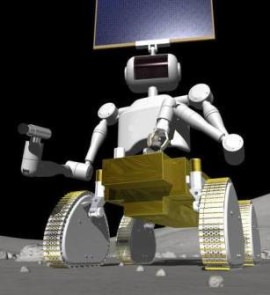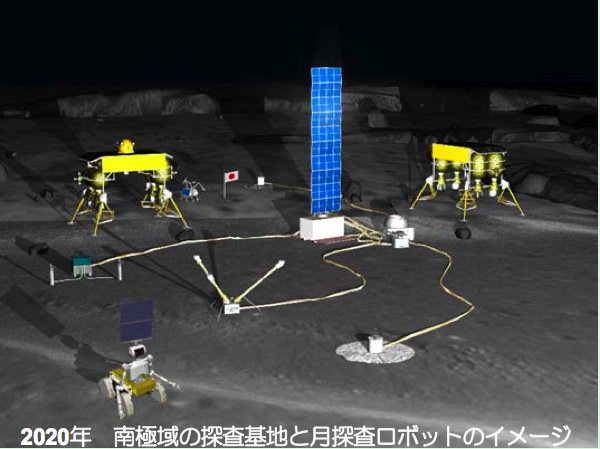[/caption]
These ARE the droids we’ve been looking for. The Japanese space agency, JAXA, has plans to build a base on the Moon by 2020. Not for humans, but for robots, and built by robots, too. A panel authorized by Japan’s prime minister has drawn up preliminary plans of how humanoid and rover robots will begin surveying the moon by 2015, and then begin construction of a base near the south pole of the moon. The robots and the base will run on solar power, with total costs about $2.2 billion USD, according to the panel chaired by Waseda University President Katsuhiko Shirai.

Some of the planned droids weigh about 300 kg (660 pounds) and move on tank-like treads. Reportedly, they will be able to operate within a 100 km (60 mile) radius of the base. They’ll be equipped with solar panels, seismographs to investigate the moon’s inner structure, high-def cameras, and arms to gather rock samples, which will be returned to Earth via a sample return rocket.
The exact location for the base will be chosen from high-resolution images returned by Japan’s Kaguya orbiter, which has provided stunning images of the Moon’s surface.
Previously, JAXA had set a goal of constructing a manned lunar base starting in about 2030, and apparently, the robotic base would be a precursor. That plan calls for astronauts to visit the Moon by around 2020 which is about the same timetable as the Indian Space Research Organization (ISRO) is hoping to have a manned mission to the Moon. The China National Space Administration (CNSA) has said they would like to have a manned lunar mission in 2030. NASA? Not sure yet. The Constellation program to return to the Moon has seemingly been axed, but it’s not going down without a fight from members of Congress and others. But surely, even if NASA decides an asteroid or Mars is their destination of choice, they would have to start by practicing on the Moon.
Let’s all work together on this and perhaps returning to the Moon will actually happen.


Kinna makes me want to fire up my Gold Wing and go for a lil ol RIDE! (Cept its still raining again here in No. Cal.)
Cool! It reminds me of the MARS underwater cabled observatory off the coast of Monterey and Santa Cruz.
http://www.mbari.org/mars/general/why.html
This is largely the way to go. Robotic systems on the moon could be used to expand a growing infrastructure, which in time could involve constructing astronomical iand other scientific instruments. If there ia a manned presence at all it should be employed as a facilitator in the deployment of systems and maintenance or repair work beyond the abilities of robots. Yet in general I think the space frontier is going to be inhabited by robots.
LC
I don’t care who is going up, as long as I have a front-seat and a live web cam that I can follow what they are doing.
And I hope they visit the Apollo landers to see how the materials aged all this time.
Kind of a small base, looks like maybe two drones.
The one problem I have with robots is that it is claimed they can’t (yet) do the job of trained geologists or paleoanthropologists when surveying geology respectively life traces.
But yes, if that capability can be achieved, there is no other exploration purpose to go to the Moon beyond the research. It is not necessary for exploring other sites, say Mars. The systems are tested out here first in any case just as for Apollo.
Practice could be good but if not it is a moderate risk to find out on Mars that you need to cut the trip short because the infrastructure doesn’t fit the task. The one component that absolutely need practice is the crafts, and that is in the current plan with orbital and NEO visits.
As for resources and staging posts, I assume NEOs and Lagrange points are better choices. The one unique non-science resource that the Moon has is its tourism value.
And when I say “practice could be good”, I’m not including the cost in increased NASA budget and the added years of time, if the project is to visit Mars. The current plan is the cheaper, faster one, and what is not to like about that?
Looks like Heinlein’s vision of an Asian-colonized Moon looks more and more plausible every day. I just hope they name the central computer at the robotic base Mycroft.. and that it is complex enough to develop sentience 🙂
On a serious note though, robotics are really the way to go for the moon. It’s completely uninhabitable, has no prospects of ever being terraformed, has few resources to support a dome (or underground) base, and no real mining potential other than Helium-3. Why not have robots do the job?
The radio lag time between here and there is an annoyance, certainly, but not nearly as extreme as anywhere else in the solar system, and so close that near real-time operation of the robots is possible and they need very little autonomy built in.
take my love
take my land
take me where I cannot stand
I don’t care
I’m still free
you can’t take the sky from me
take me out
to the black tell ’em I ain’t coming back
burn the land
and boil the sea
you can’t take the sky from me
have no place
I can be
since I found Serenity
but you can’t take the sky from me
He3 AND the extraction of water for fuel and breathing purposes… The water there is HUGE news! NASA has been looking at methods for using microwaves to heat the regolith for extraction purposes… as mentioned by Nancy in her Oct. 6th, 2008 article here at UT
http://www.universetoday.com/2008/10/06/extracting-water-from-the-moon-with-basic-home-appliances/
Which has no market besides research use which apparently is supplied well enough from cheaper sources.
I’m not sure why it is mentioned at all. It is a common plot device in scifi, apparently at some time or other proposed on weak grounds as a preferable fusion fuel source.
This article explains the problems with that. If we proceed from D-T fusion, D-D fusion is the natural technology as it has the same range of containment criteria and over all radioactivity as other reactions beyond D-T.
And since there is plenty of lithium to make tritium and another order of magnitude of containment needed for other reactions, we are talking generations of reactors here, so centuries in the future in any case. (Lithium shortage only applies to high lithium use rate technologies such as the general use of battery appliances.)
Except for such solar wind products, the Moon is plenty much as the Earth, with lesser crust-core differentiation and a deeper gravity potential than NEOs. NEOs that have more interesting variance than the chondrite character of Earth material.
Torbjörn Larsson OM:
That is until British lager louts and hooligans turn up and spoil everything!
[weekend] Aaah, lager… om nom nom.
Well, the Japanese are doing the logical . 1st a robotic mission to build and establish a base!
This is what the US should do as well.
step 1
Establishing a robotic base on the moon before 2015,
step2
between 2015 and 2020 humans could be inhabit the base build by robots.
step3
using the experience gained from step 1, a robotic base can be established on Mars by 2020 preparing the arrival of mankind.
step4
with the experience gained man may establish a robotic base on Titan by 2025, again to prepare for the arrival of man.
Why the hurry?
For one we are running out of time and must look for alternative land to colonize.
By 2050 the first colonies could well be established on the Moon, Mars and maybe Titan (one of the most interesting moons in the ‘Solar System’)
During the 4 coming decades mankind will develop new technologies and materials to withstand alien environments and propel vehicles faster and further.
I have always asked myself WHY the US has been to the moon to wait 30+ years to try it again, considering the inferior technology THEN.
Best is of course a concerted effort by the US, EUROPE, JAPAN, INDIA and RUSSIA.
Let the Chinese sink plenty of money into their own efforts, just to find their limits.
It is possible, so let’s start NOW, before water levels rise on earth preventing any future attempt.
@ikepod
Lol @ your timeframes. Very cute post.
“before water levels rise on earth preventing any future attempt.”
Somebody has been watching 2012 a little too much. (=
I don’t know if there will ever be large scale colonies on the moon or elsewhere. The idea of lunar tourism is of course a bit nuts, for only billionaires will be able to buy a ticket. Heinlein was in some ways on track with the idea of an Asian lunar colony, at least to the extent that Asia is coming to dominate the world. Heinlein also had the US falling under a theocracy, which in part I think is going to happen. The Obama period is just a sort of political indian summer in a multi-decades long process whereby the US declines into extreme right winged politics and theocratic control.
LC
I wasn’t really considering if the tourism resource was feasibly extractable, but I would agree with you that there is at least a small market. Mass market will be a long time off, let’s see what happens with the current orbital and coming suborbital tourism first.
[Actually tourism would likely expand on the exploitation, since LEO/Moon transfer cost will mostly lie in the lift up Earth gravity well. There could be a reasonably cheap path to expanding a small exclusive market by lifting the Earth-Moon transfer fuel (liq H and O) from the much smaller Moon (H2O) gravity well instead.
These benefits would then also expand to existing LEO markets. But that is as far as I can take my speculation for now.]